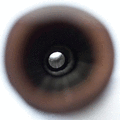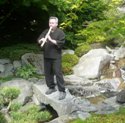Mujitsu and Tairaku's Shakuhachi BBQ
World Shakuhachi Discussion / Go to Live Shakuhachi Chat
You are not logged in.
Tube of delight!
#1 2009-03-09 14:37:59
- udo.jeromin
- Member

- Registered: 2007-05-07
- Posts: 72
different meri/kari techniques
Please let me know if this is already covered in another post.
As I understand, meri/kari is obtained by different blowing angles, most easily obtained by changing the head position ("nodding").
While in Japan last year I learned that meri/kari can as well be obtained by changing the upward pressure of the instrument. This seems to come from the Minyo and Myoan/Fuke traditions (at least that's the contexts in which I came about it).
It seems that the angle of the blowing edge has much to do with what works well on a particular instrument. Also, my impression (which may just reflect my own ignorance) is that the base (kari) position and the embochure are different for both techniques: less "vertical" kari position and softer lips for the "pressure technique".
Does anyone have comments or advice?
Offline
#2 2009-03-16 19:21:45
- udo.jeromin
- Member

- Registered: 2007-05-07
- Posts: 72
Re: different meri/kari techniques
edosan wrote:
Here is another well done deconstruction of kari/meri technique that might be useful. From the website of Andrew MacGregor: http://www.japanworldmusic.com/karimeri.htm
Not two but three kari/meri techniques well explained. Thanks edosan.
Offline
#3 2009-03-17 08:58:09
- lowonthetotem
- Member

- From: Cape Coral, FL
- Registered: 2008-04-05
- Posts: 529
- Website
Re: different meri/kari techniques
softer lips for the "pressure technique".
I think that a more relaxed embochure in which the airstream is focused against the back of the lower lip works best. It can even fill the area between the lower lip and the teeth with air pressure, causing the lower lip to balloon a little.
"Turn like a wheel inside a wheel."
Offline
#4 2009-03-17 11:49:56
- Taldaran
- Member

- From: Everett, Washington-USA
- Registered: 2009-01-13
- Posts: 232
Re: different meri/kari techniques
I am a beginner player and builder so take what I am saying with a grain of salt, but I have also found from my own experimentation with making flutes with different utaguchi profiles that a shallower dip in the utaguchi curve (depth of cut into the bore) and a tiny bit of relief on the underside of the utaguchi really helps. Downside is, it seems to makes the flute a tiny bit quieter. Slightly larger holes make up for any losses in volume.
I made a two incorporating what what Dan Shinku does with his utaguchi. Pure genius! For me at the beginner level of my technique, they are very mellow but expressive. I imagine that in the hands of someone who really knows how to play, that utaguchi profile can support some real magic!
Christopher
“Whoever can see through all fear will always be safe.” Tao Te Ching
Offline
#5 2009-05-13 13:36:12
Re: different meri/kari techniques
Udo & Ed - that is a fantastic link. I am currently polishing ri meri and hi meri. Ri meri is suffering from breathiness, but when I try to focus in with a tighter embouchure, the 'breath stream laser' can get off target. Hi meri, in the meantime, requires a greater chin dip for me and greater finger shading, no matter how much I try to get away from finger shading. It's quite humbling to just practice G minor arpeggios (very, very slowly, with long pauses while eyeing a tuner).
Offline
#6 2009-05-13 15:23:42
- edosan
- Edomologist

- From: Salt Lake City
- Registered: 2005-10-09
- Posts: 2185
Re: different meri/kari techniques
axolotl wrote:
Udo & Ed - that is a fantastic link. I am currently polishing ri meri and hi meri. Ri meri is suffering from breathiness, but when I try to focus in with a tighter embouchure, the 'breath stream laser' can get off target. Hi meri, in the meantime, requires a greater chin dip for me and greater finger shading, no matter how much I try to get away from finger shading. It's quite humbling to just practice G minor arpeggios (very, very slowly, with long pauses while eyeing a tuner).
Ri meri and Hi meri are a bugger (stating the obvious), and there are no tricks for them beyond a lot of playing; long tones (and those arpeggios, of course, because you've got to get them on the fly) and embouchure development.
Last edited by edosan (2009-05-13 15:24:30)
Zen is not easy.
It takes effort to attain nothingness.
And then what do you have?
Bupkes.
Offline
#8 2009-05-21 09:31:24
- lowonthetotem
- Member

- From: Cape Coral, FL
- Registered: 2008-04-05
- Posts: 529
- Website
Re: different meri/kari techniques
For both Dai Meri and Kari on some notes, sometimes I have to turn my head to the side a little and pull the flute away from my lips to one side to get the proper tone. I also hold some of the breath back on meri notes to decrease the volume as well as lower the tone. Finally, along with tilting the head, if you are adept enough to build an air pocket behind your bottom lip, you can push the flute into that air cushion a little to acheive the correct tone for Meri notes.
"Turn like a wheel inside a wheel."
Offline
#9 2009-05-21 09:35:00
- Christopher B.
- Member

- From: Berlin, Germany
- Registered: 2009-03-17
- Posts: 235
- Website
Re: different meri/kari techniques
Hi all,
as I learned from my teacher last time he sayed just imagine a clock, Kari is at 12 and Meri is at 6 so just turn the head around the clock to switch the pitches, also lower the breath if you get closer to 6.
Last edited by Christopher B. (2009-05-21 09:36:09)
In reality it is Ha,Ro,Ha,Ro... ~Sensei~
-------------------------------------------------------------------------
How do you know that life is a dream? Cause there is a way to wake up!
http://naturalbreath.wordpress.com/
Offline
#10 2009-05-21 12:11:30
- lowonthetotem
- Member

- From: Cape Coral, FL
- Registered: 2008-04-05
- Posts: 529
- Website
Re: different meri/kari techniques
I just started learning Sanya (version 2 in the Yokoyama Koten Honkyoku collection). It seems like an excellent piece for refining meri techniques. It is meant to be a soft piece, at least in the Yokoyama school of thought, so Tsu's are often "replaced" with Re Dai Meri's and Re's are "replaced" with Chi Dai Meri or U Dai Meri (I think I have that right). There are also several Ro Dai Meri to Ro combinations.
"Turn like a wheel inside a wheel."
Offline
#11 2009-05-27 08:11:50
Re: different meri/kari techniques
Question: Do you change embouchure or just "half"-hole in order to get the pitch of ri-meri?
Half-holing works fine with me, but don't I miss something important regarding tone color and projection?
Thanks a lot.
Marek
In passionate silence, the sound is what I'm after.
Offline